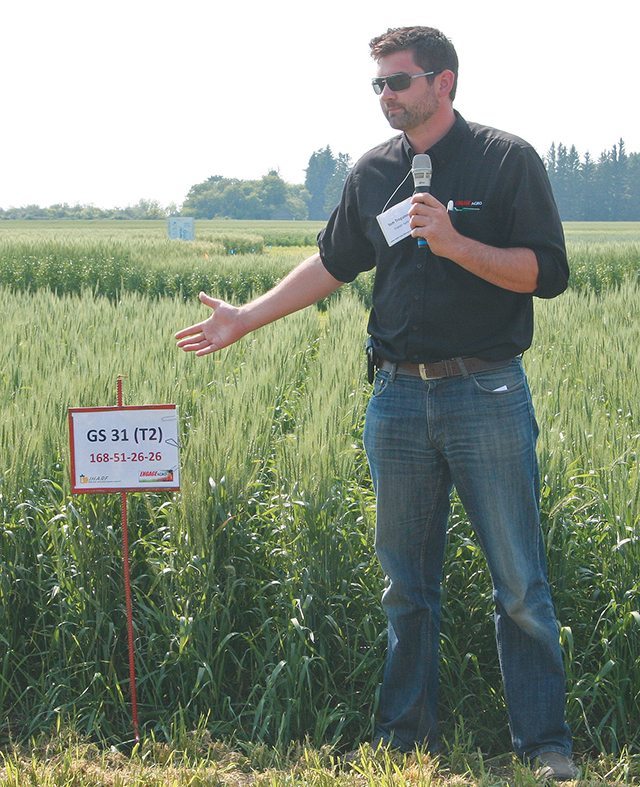INDIAN HEAD, Sask. — Reduced lodging and increased yields are two benefits seen at prairie research sites that have been testing a new plant growth regulator.
PGRs are widely used in the horticulture industry and on golf course grasses but haven’t taken off in grain production because previous generations of the products hurt yields.
However, current trials show that at least one, Manipulator, could live up to the promise of shortening the crop to keep it from lodging while maintaining good yields.

Trials at Outlook, Sask., and Indian Head, Sask. clearly show a difference in height between crops with and without PGR application.
Manipulator should be available for wheat, including durum and winter wheat, by next year, said Tom Tregunno, product manager at Engage Agro, the Guelph, Ont., company that is working to register the regulator.
“We’re already working on barley and oats and rye and we’ll probably expect that in 2016,” he said at Indian Head.
Tregunno said Manipulator works on a hormone called gibberellins, which is responsible for causing the plant stem to elongate.
“You spray it on and it prevents the biosynthesis of that hormone. You end up with a stockier, shorter plant.”
Read Also

Final crop reports show strong yields, quality
Crops yielded above average across the Prairies this year, and quality is generally average to above-average.
Research trials into the best time to apply PGRs have concluded that the five- to six-leaf stage, or growth stage 31, is optimal.
“You can tell that timing if you reach down at the base of the plant,” Tregunno said. “If you can crush the stem and it’s hollow, you know you’re at growth stage 30, 31.”
Missing the application window isn’t a disaster but it’s better earlier.
Later applications could mean shrinking the peduncle height rather than the stem, which could reduce lodging. However, Tregunno said research hasn’t shown that yet.
He also said research has shown no difference in root mass.
Even Tregunno was impressed with the dramatic difference between treated and untreated Unity winter wheat stands at the Indian Head Agricultural Research Foundation plot.
IHARF research manager Chris Holzapfel said it was typical.
“We’ve seen this every year that we’ve applied this product,” he said.
“It’s really quite astounding.”
Previous years have shown that lodging still occurs with PGR application, but at the highest fertility levels. That hasn’t happened yet this year.
Last year’s study examined three fertility levels — 100 percent, 125 percent and 150 percent of a typically recommended package — with early, optimal and split application times of Manipulator. It found that any application of PGR decreased plant height when compared to no application.
“Our combination of PGR applied at the optimal time, so growth stage 31, plus the highest fertility package, actually got an average of 90 bushels per acre of spring wheat,” Holzapfel said.
Other spring wheat varieties yielded up to 75 bu. per acre, so all crops did well, but the PGR application resulted in a clear winner, he said.
All the treatments lodged, and lodging was most severe at the highest fertility level. The highest yields were seen in the 150 percent fertility treatment with a late or split application of the PGR.
Tregunno said more work is needed in the area of fertility and whether there are “breaking points” by variety. A field-scale demonstration under irrigation at Outlook last year found a 13 centimetre reduction in height on wheat and a nine bu. per acre yield benefit.
The product is not yet registered, but Tregunno predicted it would cost $10 to $15 per acre.















